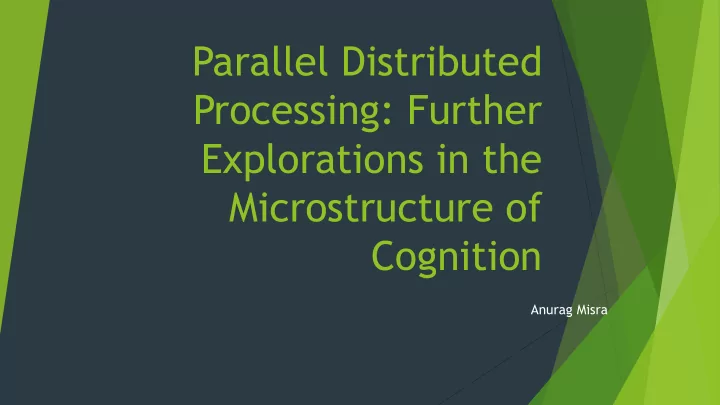

Parallel Distributed Processing: Further Explorations in the Microstructure of Cognition Anurag Misra
Advent of the theory Previously mind viewed as a discrete symbol processing system, similar to a turing machine or a serial digital computer Learning was cast as something of a discrete all-or-nothing process, executing instructions in a sequential manner By late 1970s, models built on this assumption were failing. It provided initial motivation for PDP
Motivation for PDP: All aspects of processing can simultaneously influence and be influenced (Rumelhart) Problems in parsing sentences Fail to demonstrate categorical distinction between ‘algebraic - like’ rule following cases and similarity based patterns Investigation on effects of brain damage on functions of brain Making rule based systems more graded, probabilistic and sensitive
PDP Model Neurons can be viewed as simple processors that integrate information from many different sources, operate in parallel and often reciprocally connected for mutual constrain to graded constraint satisfaction, context effects and sensitivity to both structure and content Synaptic connections between neurons can vary in their strength, hinting at an account of the inherently graded and variable nature of both healthy and disordered behaviors cognitive processes and representations often have quite regular and elegant structure that may appear to reflect accordance with some set of rules or principles of design
Central Tenants Cognitive processes arise from the real-time propagation of activation via weighted connections Processing is interactive Knowledge is encoded in the connection weights and learning and long-term memory depend on change to connection weights Learning, representation, and processing are graded, continuous, and intrinsically variable Processing, learning, and representation depend on the statistical structure of the environment
Variety in PDP Models Relation to relational and computational level models Modeling time dependence of outcomes or by including pressure to respond quickly in the objective function\ Neurons and connections constrain the nature of solutions found Explicit representation of the details of the computational problem Explicit rational or computational-level analyses
Impact of PDP Approach Illustrating how highly generative, productive aspects of behavior might be supported by mechanisms that do not implement explicit rules Origins of knowledge and developmental change: Rethinking innateness Impact on cognitive neuropsychology: Explanation without the transparency assumption Impact on machine learning Impact on theories in particular cognitive domains
Limitations and Controversies Limitations and criticisms of back propagation Lack of transparency PDP models cannot capture abstract relational structure PDP models are too flexible
Future of PDP Probabilistic models of cognition Role of “statistical learning” widely appreciated in development Acceptance of sensitivity to both specific and general information Resurgence of neural networks in machine learning Advent of computational cognitive neuroscience Distributed representations are being taken seriously by cognitive neuroscience
References Parallel Distributed Processing at 25: Further Explorations in the Microstructure of Cognition Timothy T . Rogers, James L. McClelland, Department of Psychology, University of Wisconsin-Madison, Department of Psychology, Stanford University. Received 29 July 2013; received in revised form 2 April 2014; accepted 9 April 2014
Recommend
More recommend